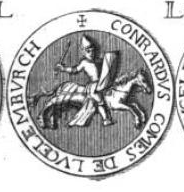Related Research Articles

Year 1004 (MIV) was a leap year starting on Saturday of the Julian calendar.
Rudolph II, a member of the Elder House of Welf, was King of Burgundy from 912 until his death. He initially succeeded in Upper Burgundy and also ruled as King of Italy from 922 to 926. In 933 Rudolph acquired the Kingdom of Lower Burgundy (Provence) from King Hugh of Italy in exchange for the waiver of his claims to the Italian crown, thereby establishing the united Kingdom of Burgundy.

Otto I, called Otto of Worms, a member of the Salian dynasty, was Duke of Carinthia from 978 to 985 and again from 1002 until his death.
Adalbert II, called the Rich, son of Adalbert I, Margrave of Tuscany and Rothild of Spoleto. He was a grandson of Boniface II, and was concerned with the troubles of Lombardy, at a time when so many princes were contending for the wreckage of the Carolingian Empire. Before his father died in 884 or 886, he is accredited the title of "count". He inherited from his father the titles of Count and Duke of Lucca and Margrave of Tuscany.
Conrad III, a member of the Ezzonid dynasty, was Duke of Carinthia and Margrave of Verona from 1056 until his death.
Conrad I, called the Great, a member of the House of Wettin, was Margrave of Meissen from 1123 and Margrave of Lusatia from 1136 until his retirement in 1156. Initially a Saxon count, he became the ruler over large Imperial estates in the Eastern March and progenitor of the Saxon electors and kings.

OdoI was margrave in the Saxon Eastern March of the Holy Roman Empire from 965 until his death.
Gero II was the eldest son of Thietmar, Margrave of Meissen, and Schwanehilde (Suanhild), daughter of Herman, Duke of Saxony. He was therefore probably a grandson of Hidda and Christian of Thuringia and named for his great uncle Gero the Great. He succeeded his probable uncle, Hodo, as Margrave of the Saxon Ostmark including Mark Lausitz (Lusatia) in 993 upon the death of margrave of Lusatia Hodo or Odo I, Margrave of the Saxon Ostmark.
Werner was the Margrave of the Nordmark from 1003 until 1009. He was a cousin of the contemporary bishop and historian Thietmar of Merseburg.
Thietmar (IV) (born ca. 990; died 10 January 1030) was the Count of the Schwabengau and Nordthüringgau from 1010 and the Margrave of the Saxon Ostmark from 1015 until his death. He was the son and successor of Margrave Gero II. His mother was Adelaide.
Dedi was the Margrave of the Saxon Ostmark from 1046 and a claimant for the title of Margrave of Meissen from 1069. He was the second son of Dietrich II of Wettin and Matilda, daughter of Eckard I of Meissen.
DediII, called the Younger, was the Margrave of the Saxon Ostmark in 1069.

Wiprechtof Groitzsch was the Margrave of Meissen and the Saxon Ostmark from 1123 until his death. He was born to a noble family of the Altmark, the son of Wiprecht of Balsamgau and Sigena of Leinungen. After his father's death in 1060, he was raised at the court of Lothair Udo II, Margrave of the Nordmark, in Stade.
Henry of Groitzsch was the second son of Wiprecht of Groitzsch and Judith, daughter of Vratislaus II of Bohemia. He succeeded his father as burggrave of Magdeburg in 1124.
Theodoric I was a nobleman in the Duchy of Saxony, and the oldest traceable member of the House of Wettin. He is an ancestor of Charles III, the King of the United Kingdom and the 14 other Commonwealth realms, through his descendant Prince Albert of Saxe-Coburg and Gotha.

Conrad I was count of Luxembourg (1059–1086), succeeding his father Giselbert of Luxembourg.
Elimar I or Egilmar I was the first Count of Oldenburg and thus founder of the House of Oldenburg. He reigned from c. 1091 to 1108.

The Schwabengau was an early medieval shire (Gau) in the Eastphalia region of the medieval Duchy of Saxony. Ruled by the House of Ascania, it became the nucleus of the later Principality of Anhalt, today part of the German state of Saxony-Anhalt.
Dedo I may refer to:

Dedi III, nicknamed the Fat, a member of the House of Wettin, was Margrave of Lusatia from 1185 until his death.
References
- Jackman, Donald. Criticism and Critique: Sidelights on the Konradiner. Oxford: Unit For Prosopographical Research, 1997.